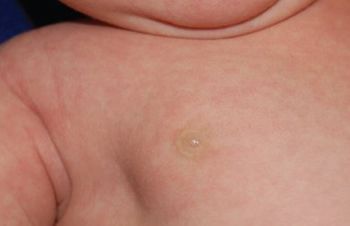
Investigators assessed the relationship between adenovirus 36-specific antibodies and obesity in children to test the hypothesis that this type of viral infection may play a role in the epidemic increase in prevalence of pediatric obesity.

Investigators assessed the relationship between adenovirus 36-specific antibodies and obesity in children to test the hypothesis that this type of viral infection may play a role in the epidemic increase in prevalence of pediatric obesity.

After laying groundwork in gene therapy for a couple of decades, we are now on the cusp of reaping benefits and are actually seeing efficacy in a large number of patients.

Physicians should be on the alert for secondary bacterial infections in children with H1N1.

Recognition and treatment of disease remain important responsibilities of pediatricians, but increasingly we've come to understand that significant improvements in child health in the 21st century will require changes in behavior that are as pivotal as advances in drugs and technology.

In response to a need for simple and rapid diagnostic tools for tuberculosis in high-burden countries, investigators assessed the performance of Xpert MTB/RIF, a fully automated molecular test, for the presence of Mycobacterium tuberculosis and resistance to rifampin in 1,730 patients with suspected drug-sensitive or multidrug-resistant pulmonary tuberculosis.

This year, a surprising number of new technologic innovations became available for primary care pediatric practice.

Children who suffer from recurrent or functional abdominal pain may need to be tested for fructose intolerance.

Parents of children with developmental or physical disabilities are likely to ask their pediatricians for guidance regarding toy selection at the holidays.

A recent study offers reassurance to breastfeeding women that they won't be missing out on sleep.

You are asked to evalute a fussy 6-week-old infant with a rash that started on her left axilla 3 weeks ago and spread to the left arm, chest, and abdomen.

Pediatric healthcare practitioners are often faced with patients and their parents who have difficulty accepting or following through with medical advice on issues such as diet and exercise or vaccine administration.

A comparison of 3 different concentrations of nebulized saline with epinephrine in infants with acute bronchiolitis showed that 5% saline may be superior to 0.9% normal saline for early outpatient treatment.

My 18-month-old son has had a diaper rash, with no other symptoms, within a few days of eating a poached egg on 3 separate occasions.

We congratulate Consultant For Pediatricians Editorial Board member Deepak M. Kamat, MD, PhD, who was presented with the 2010 American Academy of Pediatrics (AAP) Education Award at the National Conference & Exhibition in San Francisco last month.

The mother of a 5-week-old boy was concerned about a swelling under her infant’s right nipple. A 2-cm, movable subareolar mass was palpated on examination.

A newborn girl was noted to have talipes calcaneovalgus, excessive dorsiflexion of the foot that allows its dorsum to come into contact with the anterior aspect of the lower leg- the toes point upward, the arch is flat. The right foot was normal. The infant had no other abnormalities.

Parents can express their doubts about vaccination in various ways: they can have their child vaccinated, although they are not sure it is the best thing to do; they can delay immunization; or they can simply refuse to have their child vaccinated. The most frequent reason for nonvaccination is concern that the vaccine might be harmful.

The incredible success of vaccination worldwide has not been without its share of setbacks, challenges, and controversies. While the fear of vaccine-preventable diseases has greatly diminished, new concerns about vaccine safety and the increasing number of required immunizations has led to public skepticism and parental refusal of vaccines.

A year has passed since publication of the Pyrmula et al study, which concluded that prophylactic antipyretics before vaccination should not be routine. The researchers came to this conclusion because they found reduced antibody responses to several vaccine antigens in children who received antipyretics, even though the vast majority of children studied (those given antipyretics and those not given antipyretics) had antibody titers well within the protective ranges.

The frequent visits that pediatricians have with infants are bittersweet. While they are wonderful opportunities to form lasting relationships with families, they are also times when babies suffer through the necessary pain of multiple immunizations.

Autism : Clinical pears for primary care Puzzler : Toddler with vomiting after head injury Dermcase : Every day is a bad hair day Female athlete triad in adolescents

A nearly 3-year-old boy is being referred for evaluation of head trauma and persistent vomiting.

FDA has approved the first nonstimulant medication that can be used either conjunctively with psychostimulant medications or as monotherapy to treat attention-deficit/hyperactivity disorder in children and adolescents aged 6 to 17 years.

Autism spectrum disorder consists of qualitative impairments in social interactions and communication and the presence of restrictive or repetitive behaviors, interests or activities as defined by the Diagnostic and Statistical Manual of Mental Disorders, fourth edition.

Diagnosing respiratory syncytial virus is a challenge because its symptoms are similar to other respiratory illnesses.

To determine the incidence of occult pneumonia among children who have chest radiography and to identify clinical predictors of occult pneumonia, researchers conducted a prospective observational study in an urban pediatric emergency department.

Investigators in Scotland set out to determine whether that country's ban on smoking in public places, initiated in March 2006, influenced the rate of hospital admissions for childhood asthma.

It's been 50 years since the publication of the first study demonstrating that chest compressions can be a life-saving measure for victims of cardiac arrest and 5 years since the American Heart Association published their 2005 Guidelines for Cardiopulmonary Resuscitation and Emergency Cardiac Care.

The Title IX provision of the Education Amendments passed in 1972 prohibits discrimination regarding access to educational programs and activities that receive federal financial assistance.

The US Food and Drug Administration recommended in 2007 that over-the-counter cough and cold medicines not be given to children younger than 2 years old, but a recent study shows that parents have not gotten that message.